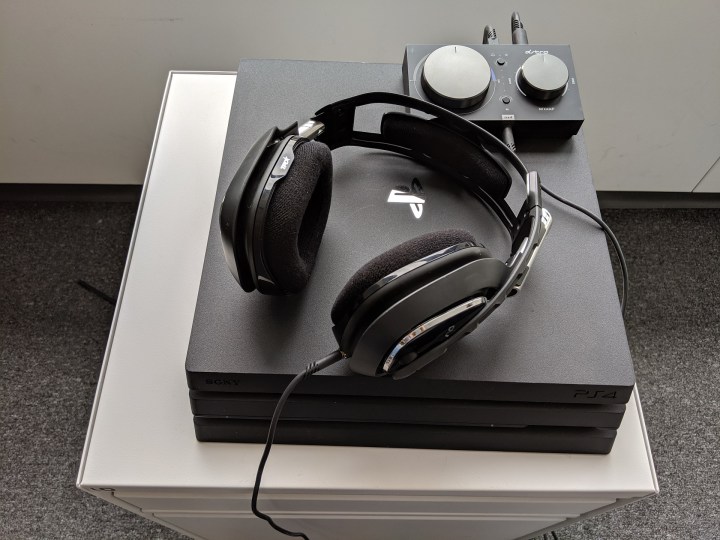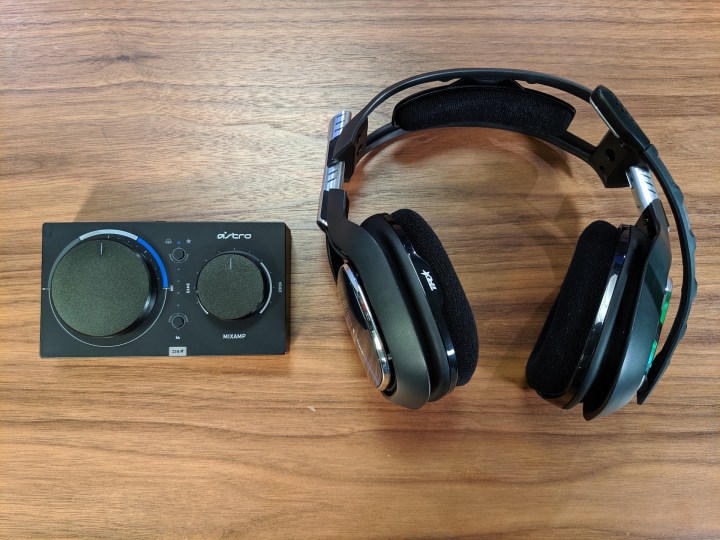
Astro gaming headsets are synonymous with quality. If you’ve ever asked your gaming pals about recommendations for a good headset, Astro is a name you’ll likely hear come up. After years of wondering if this hearsay was all hype, I decided to find out for myself.
Easy to use with a subtle yet eye-catching design and the best sound I’ve heard from a gaming headset, the Astro A40 TR and Mixamp TR do not disappoint. However, the $250 price tag is difficult to justify. Although its capabilities are beyond those of your typical gaming headset, it comes at a price only competitive gamers, content creators, and streamers will understand.
Pay to pro
Inside the box, you’ll find both the Astro A40 TR headset and Mixamp Pro TR, along with a swappable boom microphone and auxiliary, Micro-USB, TOSLink Optical, and Digital Daisy Chain cables. All of these cables, sans the auxiliary, will only be used if you’re using the headset with the Mixamp Pro.
The headset itself is sleek and stylish, sporting two metal pipes on each side that allow you to adjust how high or low the ear cups sit, but also add some flair, resembling the exhausts you’d find on a truck. It’s actually kind of adorable, in a Transformers cosplay kind of way. The headset is also incredibly comfortable, with soft cloth cushions and ear cups that cover the entire ear. The ear cups didn’t press too firmly against the sides of my head, which is a plus, especially since I wear glasses.
The stock speaker tags, which are the removable plates on the back of the ear cups, are bland, but you can purchase flashy replacements on the Astro Gaming website. They can be swapped out with closed-backed noise isolating speaker tags using a mod kit, which you’ll again have to dish out additional money for.
Customization is a highlight of the Astro A40 TR headset. Everything from the cloth cushioning on the ears and headband to the speaker tags and boom mic can be replaced. The option to go from open to closed-backed is particularly cool, but it can cost you an additional $40 – $60 on top of the already pricey $250 you’ll spend for the headset and Mixamp. It would make more sense if a mod kit was included in this bundle, especially since the A40 TR touts itself as a premium gaming headset.
I do enjoy the Astro A40 TR’s minimalist design. It’s a wired headset that doesn’t have any onboard controls, save for an inline mute button found along the auxiliary cable. That means any kind of volume and preset control is limited to the Mixamp Pro TR. While you can purchase the headset and Mixamp separately, the duo compliment each other well. It might not bode well for players who want the ability to control their sound using the headset, especially when the Mixamp isn’t connected.
Costly but capable
Video game audio mixers, like the Turtle Beach Elite Pro TAC and Astro Mixamp Pro TR, are different from audio mixers you’d use for music or radio. They feature ports that are specific to gaming, and are most beneficial to competitive players and/or streamers and content creators.
That said, the Mixamp Pro TR is a nice piece of hardware. It has two dials: The bigger knob controlling volume and the smaller knob regulating the game/chat audio balance. This lets you prioritize the audio you want to hear more, whether it be the team chat or the video game. In between the knobs are four buttons, each with its own equalizer preset. Out of the box, the presets are fairly generic, but you can customize them to suit your own preferences using the Astro Command Center application on PC or Mac.
Along the back of the Mixamp are six ports. That might seem a bit confusing at first, especially if you’ve never used an audio mixer before, and the Astro A40 TR and Mixamp Pro TR don’t come with much in the way of directions. I had to find most of my information on a very useful Reddit thread, but once I figured it out, I was impressed with the possibilities.
On either side of the Mixamp are two ports marked by a chain symbol. These are for Digital Daisy Chain cables, which can be used to connect several Mixamps together. This is useful for teams that game side by side and want to communicate locally, much like you’d find in an esports competition. I was unable to try this feature out, as I only had access to one Mixamp Pro TR.
The optical port is for the Toslink optical audio cable and connects the Mixamp Pro TR to your console or PC, although it’s not a necessity for PC use (you can just use the included Micro USB instead.) The auxiliary port can be used to add an additional source (like your phone) to the Mixamp, so you can hear it in the headset alongside game audio. The Stream port is the niftiest of the group, connecting to either a PC or capture card and merging all of your audio into one source for streaming or capture. The USB port, of course, connects the Mixamp to either your PC or console.
True versatility?

We were sent the Astro A40 TR gaming headset and Mixamp Pro TR for the PS4 and PC. It’s also compatible with the Xbox One and Nintendo Switch, but you’ll have to connect directly to these platforms via the auxiliary cable. This means you won’t be able to use the plethora of features available on the Mixamp Pro TR. The A40 TR headset continues to have incredible 3D audio even without the Mixamp, but you won’t be able to enjoy the mixer’s Dolby Audio processing.
The Astro A40 TR makes for a fine headset on its own but its true potential is fully realized when paired with the Mixamp Pro TR. The duo offer superb audio, customizability, versatility, and a considerable smattering of features that audiophiles playing competitively or working professionally in games can get substantial use out of.
The price for the A40 headset and Mixamp is a sticking point, much like the C40 TR controller, especially for players who only plan to use the two casually. It’s worth noting, though, that the closest competitors — the Turtle Beach Elite Pro headset and Elite Pro TAC — total over $3o0, so if you’re in the market for a professional-grade gaming headset, the Astro A40 TR and Mixamp Pro TR are the more affordable options. They’re great, but anyone interested in the aesthetic and base features of the headset will want to stick with just that.











